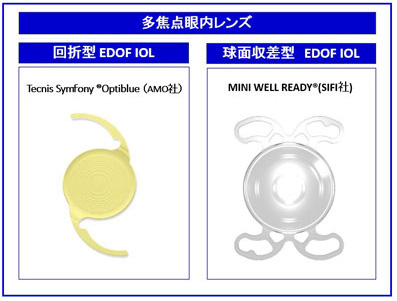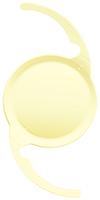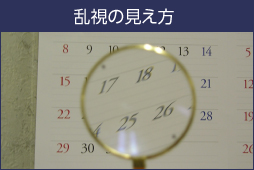![]()
The hospital is located a 5-minute walk to the east along the Shinkansen elevated from JR Fukuyama station north entrance.


Cataracts are a disease in which the crystalline lens becomes clouded.
The lens is in the eye, it corresponds to the lens in a camera. As you get older, the lens becomes clouded progressively. This is similar to the way hair gradually becomes white as you get older.
 |
 |
|---|---|
| Normal eyes | Cataract eye |
The cause of cataracts like this is mostly aging, but there are other causes such as trauma (you have hit the eye a long time ago, etc.), radiation (you have been treated with radiation, etc.) The use of certain drugs (steroid hormone drugs, etc.) , diseases such as diabetes can cause cataracts.

Cataracts may be operated on at any time unless it is too late. In the early stages of cataracts, vision will not be much worse. The cataract slowly progresses, but the visual acuity slowly worsens accordingly. Consider surgery if your life and work suffer because of cataract visual impairment.
| For example |
|---|
|
During the course of having a cataract, cataracts may cause glaucoma or cause uveitis. In such a case, doctors actively recommend cataract surgery so that it will not be too late. In order to avoid this window of opportunity, visit a reliable ophthalmologist regularly when it comes to cataracts.
In order to prevent eye infection and inflammation for a while after surgery, please keep the following points
| 1 | About 1 to 3 months after surgery, use eye drops according to your doctor's instructions  |
|---|
| 2 | Avoid facial cleansing and bathing for about a week after surgery  |
|---|
| 3 | Protect eyes from direct sunlight until the condition of eyes calms down  |
|---|
- Miniwell Lady® (SIFI) and Technics Symphony® Opti Blue (AMO) -
An intraocular lens is an artificial lens that is implanted in the eye instead of the lens extracted by cataract surgery. The intraocular lens affects the most visible operation (quality of appearance, quality of life) of various surgical items and devices related to cataract surgery.
The intraocular lens has a single focus intraocular lens and a multifocal intraocular lens. Since the single focus intraocular lens has only one focus, it requires eyeglasses frequently after surgery, but the multifocal intraocular lens has more focal points compared to the single focus intraocular lens. You can greatly reduce the frequency of glasses usage.

There are various kinds even if it is called multifocal intraocular lens In a word. Currently, the advanced multifocal intraocular lenses Minifell Lady ® (SIFI) and Technics Symphony ® Opti Blue (AMO) are called Extended depth of focus intraocular lens (EDOF) and have depth of focus. It is a completely new type of intraocular lens that was made to conceptually expand. EDOF intraocular lenses have lower contrast sensitivity (quality of appearance), halo, glare (glare), while acquiring a far wider clear vision range (range of focus) compared to single focus intraocular lenses, ghost (you can see something like a shadow), and so on. Conventional multifocal intraocular lens suffered from problems such as reduction in contrast sensitivity and secondary symptoms such as halo, glare, ghost, etc., in order to obtain high visibility capability. EDOF intraocular lens is a lens that can be used more reliably than many traditional multifocal intraocular lenses, with fewer secondary symptoms, although the near vision will be slightly reduced. Especially Miniwell Lady ® (SIFI) thinks that it is one of the most superior intraocular lenses today with fewer side effects than Tecniques Symphony ® Opti Blue (AMO).

Multifocal intraocular lenses are expensive due to their own burden, but patients who wish to reduce the frequency of use of eyeglasses after cataract surgery become more and more year by year, and more people who choose multifocal intraocular lens are increasing. * Technics Symphony® Opti Blue (AMO company) is approved by the Ministry of Health, Labor and Welfare and is subject to advanced medical insurance.
 |
 |
|---|---|
| Appearance of monofocal intraocular lens | How to see the multifocal intraocular lens |
Because multifocal intraocular lenses are highly functional, precise surgery and examination are required, and depending on the patient's eyes, personality and life, it may be worse than monofocal intraocular lenses. If you would like a multifocal intraocular lens during cataract surgery, if you are interested, please do not hesitate to contact your doctor or staff.

The Toric intraocular lens, instead of the lens cloudy in cataract surgery, intraocular lens to be implanted one of the, correct astigmatism you can. Astigmatism is caused by distortion of the crystalline lens and cornea, which is the lens of the eye. Cataract surgery eliminates the distortion of the lens, but the distortion of the cornea, another lens, remains. If there is astigmatism, symptoms such as a blurred and double appearance are seen with the naked eye even after cataract surgery . Symptoms of astigmatism are alleviated by transplanting Toric intraocular lenses and correcting corneal astigmatism in the eye.

Toric intraocular lenses are exactly the same as ordinary intraocular lenses because the risk of surgery is the same as ordinary intraocular lenses , and financial burden is also insurance adaptation.
It can be said that there are no disadvantages of Toric intraocular lenses, and our hospital is actively using it for people with adaptation of Toric intraocular lens in cataract surgery.

Normally cataract surgery is not something that must be done urgently. So it is one choice not to perform surgery immediately. If you leave it, cataracts will progress and your eyesight will slowly worsen. However, sometimes glaucoma and uveitis occur as the cataract progresses, and there is a situation that you will have to undergo surgery in a hurry.
The result of cataract surgery which is done after such an emergency situation is not as good as the result of normal cataract surgery.
Whether your cataracts will merge such glaucoma or uveitis in the future is hard to predict. Even if you decide not to undergo surgery in the near future, in order not to overlook such a period, visit a reliable ophthalmologist regularly.
Most cataracts improve only by surgery. At our hospital, cataract surgery is performed under a surgical microscope with the latest equipment and technology, and we are satisfied we can help everyone.

Cataracts (cloudy lenses) are divided into the nucleus, the cortex surrounding it, and the outermost capsule (anterior capsule and posterior capsule). The procedure of surgery to remove them is divided into 22 steps, but as a general outline, it cuts out the central part of the anterior capsule, sucks the nucleus ultrasonically, or ejects it, and aspirates the cortex. The judgment of supersonic emulsification suction (cataract ultrasonic emulsification aspiration) or expulsion (cataractus extragudectomy) depends on the nature of the cataract, this is left to the director.
Removal of the cataract will cause an object to look blurry unless it compensates the lens with only the refractive power of the crystalline lens inside or outside the eye. In our hospital, it is usual to insert a lens called an intraocular lens into the eye and end the operation (intraocular lens transplantation). Normally, intraocular lenses will not be replaced throughout their lifetime. If you do not use an intraocular lens for any reason, use contact lenses or thick glasses after surgery. Contact lenses do not need to be put in and out every day, and they can be used continuously for about a week or so.

Cataract surgery is done to improve eyesight, all the staff below the director will do their best for this purpose.
However, in rare cases, the visual acuity of surgical results may not be different from the visual acuity before surgery, or it may be worse than the patient’s previous level of eyesight. The causes include bleeding in the eye, edema of the cornea, infection, adhesion failure of the wound, retinal detachment, retinal edema, endophthalmitis, diplopia, glaucoma, dropout of the intraocular lens, late cataracts and the like . Although we take all possible measures against these complications, we also note that in rare cases it may lead to blindness as a result.
There are also complications that can occur in any other surgery. That is, abnormal reactions to local anesthetic and other drugs used during surgery, sudden cerebral hemorrhage, sudden cardiac arrest etc. These complications are hard to foresee but fortunately the frequency is very low.
Before cataract surgery, please understand the above thoroughly. Please sign the surgical consent form afterwards. Do not hesitate to ask a doctor or nurse when you do not understand, or are worried, etc. when you come to the hospital. Also, if you feel any abnormality, do not leave as it is, please do not hesitate to seek immediate medical examination.
Surgery in our hospitalCataract surgery can be done on a day trip.
Advancement of surgery has enabled cataract surgery to be more secure and accurate than ever before. At our hospital, cataract surgery is done with patients hospitalized over one night and day trip. In addition, we can accommodate you in a nearby hotel, so please consult us. Cataract surgery is done in about 10 minutes with eye drop anesthesia.
Surgery uses supersonic waves from a small wound to aspirate the turbidity of the lens and then insert the intraocular lens. Usually surgery is performed with anesthetic eye drops. It is a delicate surgical operation performed using a microscope, but do not worry about it, so relax when you see the light of the microscope. After surgery, you will wear an eye patch for 1 day. Then you will use protective glasses for 1 week. Intraocular lenses can be used permanently.

The intraocular lens works to focus instead of the removed lens. Since the lens is inserted at the original position, there is no foreign body feeling and there is no need to remove it.
Eye glasses are necessary even after cataract surgery.
Depending on the degree of the lens to be inserted, the previous hyperopia / myopia status and the use of reading glasses frequency will change. Therefore, the glasses used before surgery will not suit. If necessary, we will match the pair of eyeglasses one month after surgery, but we can rent you a pair of glasses in the meantime. Please contact us.

We safely perform cataract surgery with advanced medical technology and the latest surgical equipment.
Doctors and staff pay close attention and aim for 100% success so that many people can feel satisfying joy of restored vision.
We hope to be highly regarded and trusted as a medical institution by everyone.
![]() Reservation · Inquiries
Reservation · Inquiries![]()
※ Our hospital has reservation system.
You can make a reservation for the first time or visit again.
Telephone reservation is here
Morning / 8: 30-12: 00
PM / 15: 00-17: 00
Closed /
Saturday Afternoon・Thursday Afternoon.
Sunday · Public Holiday